The Top Ten Most Controversial Action Figures of the Modern Era
Poe Ghostal here. The recent kerfuffle over NECA’s Django Unchained figures is just the latest in a long line of controversies surrounding little plastic people. Action figures have been causing controversies almost as long as they’ve been around, so I decided to do a little digging to find some of the more notable examples.
For the purposes of this article, my criteria for a figure being truly “controversial” was that I could track down at least one legitimate news article about someone being upset about a toy. So while legend has it that parents were horrified by Kenner’s 1979 Alien figure, I was unable to find any articles on the topic – hence its absence from this list.
Anyway, here are ten of the most notable examples of controversial action figures.
10.) Austin “Danger” Powers (Austin Powers, McFarlane Toys, 1999)
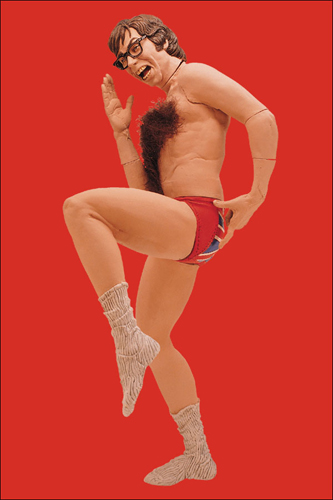 |
In 1999, McFarlane Toys made a line of action figures based on the first two Austin Powers films. The figures had voice chips. The collectible action figure movement, targeted toward older collectors, was in full swing by this time, so McFarlane developed two variants of the figures: one with fairly innocent voice chips to be sold at kid-oriented stores like Toys ‘R’ Us and other big box retailers, and others with racier lines for comic shops and other specialty stores. You can see where this is going.
One Georgia mother was rather upset when she and her 11-year-old son were at a Toys ‘R’ Us when an Austin Powers figure – clad only in underwear and socks with a chest full of “real” hair – inquired, “Do I make you horny, baby?” In a scene straight out of a cheap sitcom, her son began pestering her about the meaning of “horny.” The woman filed a complaint to TRU about the matter and went to the media. McFarlane Toys, for its part, claimed that it was a simple mix-up at the warehouse.
It remains unknown whether the figure did, indeed, make the mom horny.
9.) Zartan (G.I. Joe: A Real American Hero, Hasbro, 1984)
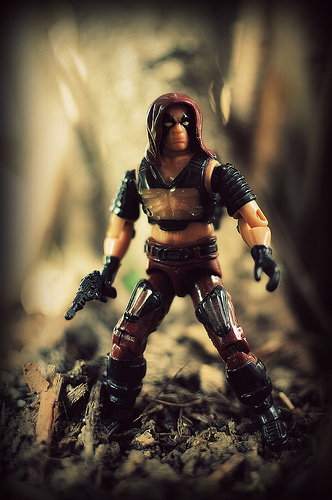 |
| Inanimate Life |
What’s that? Fan-favorite G.I. Joe villain Zartan was once controversial? Yes. Just a little. Back in 1984 when Zartan’s action figure debuted as part of Hasbro’s 3 ?” G.I. Joe: A Real American Hero toyline, each character’s packaging featured a “bio card” describing that character. This was a fairly new practice at the time, and in Zartan’s case, it caused a little controversy.
Zartan was a master of disguise. This was somewhat ham-handedly linked to a note in his “psychological profile” on his bio card, which stated, “Extreme paranoid schizophrenic. Grows into various multiple personalities to such an extent that the original personality becomes buried and forgotten.”
According to a December 1984 article from Canada’s Globe and Mail, the Canadian Mental Health Association took exception to Zartan’s characterization as a paranoid schizophrenic. CMHA president Robert Martin stated, “For years, we have been trying to fight against the stigmatization and ostracization of the mentally ill. And now this company creates the notion that the mentally ill are alien and enemy creatures, rather than people who need our help and understanding.”
The article states that “embarrassed Hasbro officials […] apologized for using the phrase ‘paranoid schizophrenic.'” The “psychological profile” section was removed entirely from the bio in later production runs.
8.) Dexter (Dexter, Bif Bang Pow, 2009)
 |
| Bif Bang Pow |
Action figures of mass murderers – even fictional mass murderers – are just not something that can come out in toy stores without someone noticing. Or at least, not the first time they show up; nowadays people don’t seem to mind all the Freddy and Hannibal Lecter figures.
In 2009, Bif Bang Pow created an action figure based on the main character of Dexter, a TV show about a serial killer who hunts other killers. The news articles from the time referred to a “controversy” that seemed to center entirely on a few people being kind of surprised Dexter action figures were being sold at Toys ‘R’ Us. No boycotts were proposed (one person filed a complaint to TRU) and the only real commentary seemed to be that, well, maybe the figures should be sold in “more appropriate stores” or something. Given the lackadaisical nature of this “controversy,” I guess by 2009 a serial killer action figure just wasn’t that shocking.
7.) Talking Freddy Krueger (Matchbox, 1989)
In 1989, Matchbox Toys produced a Freddy Krueger doll. It was one of those pull-the-string dolls clearly intended for children. Guess what? Turns out parents and won’t-someone-think-of-the-children types weren’t super-excited about talking dolls of kid-killing burn victims. Some urged a boycott of Matchbox products, so after the initial shipments, Matchbox ceased production.
The real tragedy of this story isn’t so much that the lame talking Freddy dolls were curtailed, but that the controversy sank another, far-more-awesome monster-themed toy line, Maxx FX. The line was based on the idea of dressing up a regular doll to look like a monster character. Freddy Krueger was produced (of course), but after the controversy Matchbox scotched plans for similar dolls of Dracula, Frankenstein’s Monster, the Creature from the Black Lagoon and the Alien(!). For the full story of the promising rise and the bitter fall of Maxx FX, check out this website.
6.) Steve the Tramp (Dick Tracy, Playmates, 1990)
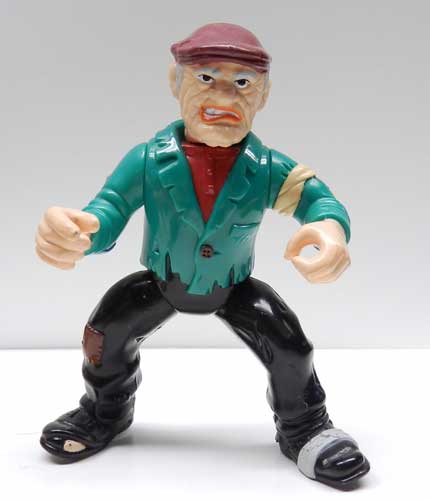 |
| Infinite Hollywood |
Steve the Tramp is a character from the Dick Tracy newspaper strip. He was first introduced in September 1932 as an abusive Fagin-type who makes Junior, Dick Tracy’s future adopted son, steal for him. Six decades later, the character made a brief appearance in the Warren Beatty film.
Playmates Toys, meanwhile, were looking to capitalize on their recent success with their Teenage Mutant Ninja Turtles toyline, which was just beginning to lose a little steam. As part of their Dick Tracy line of toys, Playmates made a figure of Steve the Tramp. The packaging noted that “you’ll smell him before you see him” and that he would “use and abuse any young helpless prey he comes across.”
Homeless advocacy groups, led by the soon-to-be-famous Reverend Christopher Rose (whose “Warped Toys” lists was an annual source of amusement for collectors in the late 1990s and early 2000s), organized demonstrations outside toy stores until the figure was pulled from shelves (by Kay-Bee toys, at least).
There is no evidence of any complaints about McFarlane Toys’ “Todd the Bum” figure, suggesting that toy-related homeless advocacy is arbitrary at best.
5.) Armed Terrorist (The Villains, 21st Century Toys, 1999)
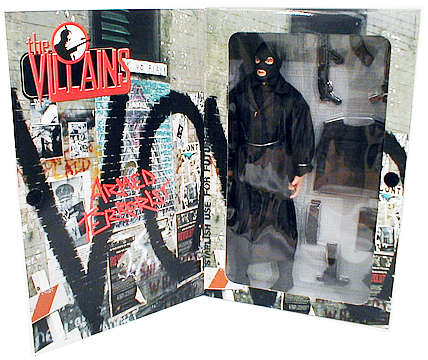 |
In late 1999, Sears began selling an action figure of an armed terrorist from a 12″ toy line called “The Villains” (designed to oppose “The Heroes”). The figure wore a ski mask and trenchcoat and came with an arsenal of weapons. To many customers, it was far too reminiscent of the perpetrators of the Columbine High School massacre that had occurred just a few months later.
Although the figure had been in development before the tragedy, Sears quickly pulled the toys after receiving a number of complaints. While any “controversy” about a toy pales in significance to the actual event, it nonetheless warrants inclusion on the list.
4.) Nomad (Rambo, Coleco, 1986)
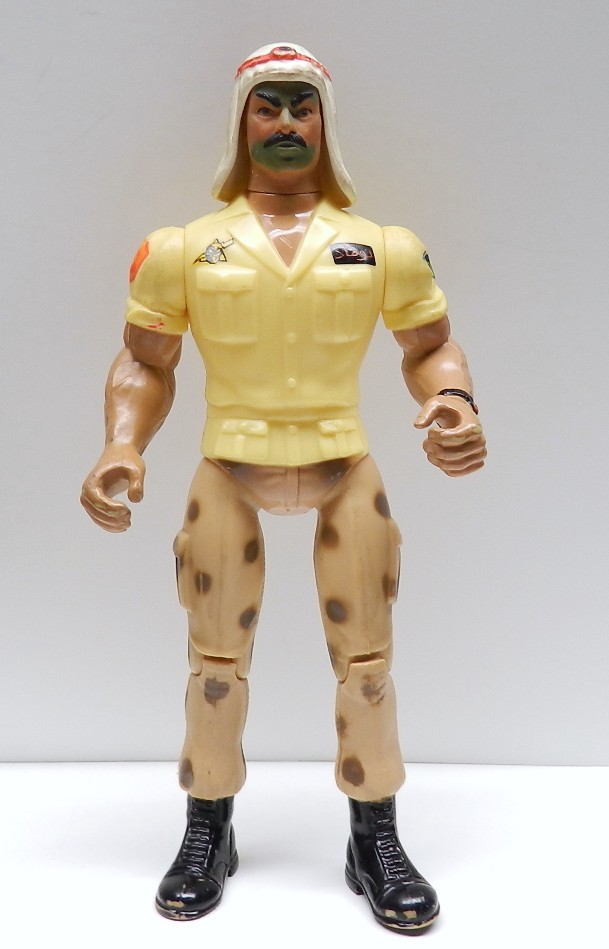 |
| Infinite Hollywood |
Though it’s easy to forget, the first Rambo movie, First Blood, wasn’t so much an action movie as a psychological thriller about a Vietnam veteran suffering from severe post-traumatic stress disorder. All that introspection went flying out the window strapped to a rocket-propelled grenade with the 1985 release of Rambo: First Blood Part II, which replaced any and all moral questions with machine guns, explosions, and Sylvester Stallone’s well-oiled pecs. It became the biggest hit of the Rambo series.
Noting popularity of both Rambo II and, presumably, Hasbro’s G.I. Joe, a Rambo cartoon and accompanying toy line was developed. Called Rambo: The Force of Freedom, it was the first kids cartoon ever based on an R-rated film (though it would soon be followed by Robocop).
When the inevitable controversy surrounding Rambo toys showed up, there was more than just the usual complains about the violence of the toys themselves. Protesters particularly complained about Nomad, the stereotypical turban-wearing Arab terrorist of the toy line. After receiving a number of complaints about the character and figure, the American-Arab Anti-Discrimination Committee successfully lobbied Coleco into ceasing production of the figure.
3.) Totenkopf Division – Normandy 1944 (Call of Duty, Plan-B Toys, 2004)
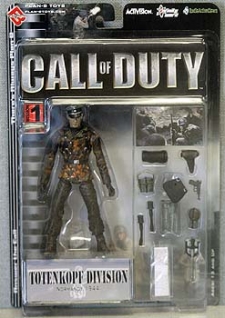 |
Man, the categories for the Guinness Book of World Records has gotten really specific these days. They apparently have a category called “Most Controversial War Video Game Action Figure.” The current record holder is Totenkopf Division (Normandy 1944), made by Plan-B Toys in 2004 for their toy line based on the videogame Call of Duty.
There were a number of different groups in the German military during WWII that were known by the name “Totenkopf” (which means “Death’s Head”) or had the word somewhere in their name. Most of them were part of the Schutzstaffel or SS, the Nazi organization among whose many tasks was the supervision of the concentration camps. The name “Totenkopf” was enough to cause complaints from Jewish groups and Holocaust survivors. Within a month of the initial complaints, Plan-B toys had discontinued the figure.
2.) Django Unchained (NECA, 2012)
 |
As most fans know by now, some action figures were made by toy company NECA for Django Unchained that caused an uproar from some civil rights groups. They claimed the figures commercialized slavery.
If I may editorialize a bit, I think the controversy might have been avoided if the figures had been done in the usual NECA style – fully plastic, realistically-sculpted 7″ figures – rather than the 1970s, Mego-like style that was used. With their fabric clothing, the figures just look too much like dolls. That made it easy for people unfamiliar with the collector action figure market to perceive them as children’s playthings rather than adult collectibles, and thus more noticeably incongruous on the toy shelf.
It’s unclear whether any of this actually affected NECA’s bottom line, though. The Weinstein Company asked NECA to stop production on the figures, but the way NECA operates, chances are the figures had all already been produced and shipped to stores by the time the controversy arose.
1.) Death Row Marv (Sin City, McFarlane Toys, 1999)
When it comes to a moral panic about toys, nothing comes close to Death Row Marv.
Back he was still creating amazing comics instead of being crazy, Frank Miller gave us Sin City. The word “hard boiled” doesn’t begin to describe Miller’s dark underworld, whose filthy streets are stalked by the likes of Marv. Described by Miller as “Conan in a trench coat,” Marv’s story ends when he is sent to the electric chair for crimes he didn’t commit (and maybe a few he did). Marv actually survives the first jolt, asking his executioners, “Is that the best you can do, you pansies?” before finally meeting his end.
Naturally, this scene cried out to be memorialized in plastic, so in 1999 McFarlane Toys created “Death Row Marv.” It not only depicted Marv in his last moments, but featured lights to represent the electricity searing through his veins and Marv himself spouting his famous line.
People went nuts over this thing. Representatives of the National Organisation of Parents of Murdered Children asked, “What will they come up with next, a rape doll? How about an incest doll?” Articles claimed “the doll is pitched at adults […] but the main buyers are children” – an assertion apparently based solely on the assumption that the only people who bought action figures were children. Many of the articles cited complaints from people who were against the death penalty, but even supporters of capital punishment such as Michelle Malkin wondered, “have we grown so accustomed to bloodlust marketed as youthful entertainment that nothing is beyond the bounds of good taste?”
McFarlane Toys, for their part, produced as many Death Row Marv figures as they could and laughed all the way to the bank.
In many ways Death Row Marv was a watershed moment in the growth of the of adult action figure market. Many of the articles focused on the incongruity of a “children’s toy” being so gruesome, bringing to mind the shocked lawn-defenders who had flipped through Miller’s The Dark Knight Returns fifteen years earlier and wondered when comics got so dark and violent.
But just as people got used to darker comics, so did they get used to darker toys. Six years later, NECA made another Death Row Marv, this time based on the film adaptation – and no one gave a rat’s ass.
